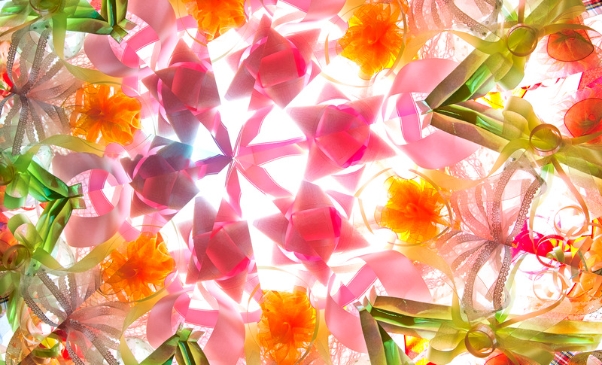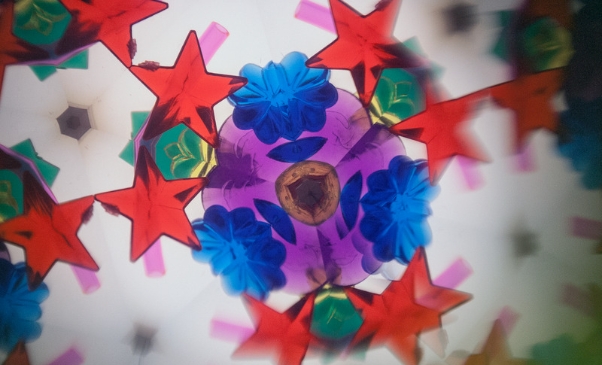People with migraines with aura are likelier to see kaleidoscopic patterns. Migraine sufferers familiar with the condition will understand what I mean when I say that aura is a common symptom. You might be able to feel this even if you don't have a headache.In the scientific literature, visual auras have been put into three categories: a positive aura, a negative aura, and a perceptual aura. Scotomas are often considered one of the most upsetting eye conditions people can have (blind spots). Visual signals include zigzag lines or flashing lights (photopsia).Experts in perceptual visual expressions agree that kaleidoscopic and fractured visions, sometimes called "cracked glass," are two sides of the same phenomenon. Kaleidoscopic vision is characterised by the fact that the mind can trick the brain in many ways, such as by making things look much bigger or smaller than they are or much farther away or closer.

What is kaleidoscope vision?Aura episodes can cause many unpleasant feelings, such as numbness or tingling, weakness, trouble speaking, and double vision. You may feel two different auras at different times. A typical aura episode could last anywhere from five minutes to one hour. Migraine-like headaches usually follow, but this is not always the case. A person with kaleidoscope vision might see blurry and too-bright images. This is because looking at a picture through your eyes is like looking at a picture through a kaleidoscope. You can make the photos switch places if you want them to.Most of the time, both eyes are affected by the condition that causes blurry vision. But this can be hard to see because it can be hidden from the rest of the observer's field of vision. You could close one eye at a time and see if the same thing happens when you close the other eye. If the distorted image shows up in both of your eyes instead of just one, it is probably due to a problem in the area of the brain responsible for seeing, as opposed to the eyes themselves. It seems likely that an ocular migraine was the root of the issue.
symptoms of migraine with auraPeople with migraines and auras are more likely to experience the following symptoms in addition to those listed above:
- Lines that are sometimes wavy and sometimes glittery (they may be coloured or black and silver, and they may appear to move across your field of vision)
- In addition to the "flashbulb" style, these effects include squiggles, dots, stars, and spots.
- A dark and foggy area that is surrounded by zigzag lines and has the potential to grow and shrink over time. This could cause you to have blind spots, tunnel vision, or even temporary vision loss.
- A feeling that is like seeing through water or going through a heat wave.
- not being able to tell one colour from another
- Things that are too big, too small, too close, too far, or all simultaneously.
There is a chance that the following signs and symptoms may go along with migraine with aura. Several forms of aura or migraine episodes may occur simultaneously with or after the visual aura episode. Among them are:
Sensory aura:A sensory aura is marked by a tingling feeling that starts at the tips of the fingers and moves up the arm. It can sometimes reach the side of the face and the tongue.Dysphasic aura:It seems like you are stumbling over your words or can't get your point across. Having a dysphasic aura is the name for this. Having a dysphasic aura is the name for this.
Hemiplegic migraine:People with migraines and hemiplegia may have weak facial muscles and paralysis of the limbs on the affected side of their body.The most common cause of kaleidoscope vision:Here are the main things that cause most people to have a kaleidoscopic vision:
Most of the time, kaleidoscopic vision is caused by migraine with aura, which can affect the eyes or the retina. About a quarter of people who get migraines are also thought to have this illness. Even though these words are sometimes used interchangeably, there is a clear difference between "ocular" and "retinal." If your doctor has told you that you have one of these conditions, you should ask your doctor for more information. If your doctor has told you that you have one of these conditions, you should ask your doctor for more information.

Types of migraine that affects the eyes
Ocular migraine:An ophthalmic migraine is a type of migraine that affects the eyes. It is also called a visual migraine or an eye headache. The aura of an ocular migraine is called "scintillating scotoma" when it comes up in a clinical exam. When someone has an ocular migraine, both eyes are often affected.When this happens, it's because the nerve cell endings in the brain's visual cortex have been turned on. There is no way to make sense of what has happened here. An fMRI may show that as a migraine worsens, activity in the visual cortex spreads to other parts of the brain.Retinal migraine:Some doctors may use the terms "visual aura," "ocular aura," and "ophthalmic aura" when they talk about migraines of the retina. But migraines that damage the retina are a much more severe problem than migraines that make the eyes uncomfortable. This disorder happens when the eye doesn't get enough blood.Monocular blindness is when a person loses all or part of their sight in just one eye because of this disorder. You might see similar things if you have an aura, which is a sign of an ocular migraine. Even though the medical terms may seem confusing, a doctor or another skilled healthcare professional can help you determine what's wrong with you.Hallucinogens:Hallucinogen use can cause migraines with visual symptoms like an aura, such as kaleidoscopic vision and other strange visual effects. This category also includes many other kinds of flaws that can be seen. LSD and MDMA, also called "molly" and "ecstasy," are known to make kaleidoscopic images; some of these images may be unstable and change quickly.Can I get rid of the kaleidoscope vision?There is currently no treatment for migraines that everyone agrees on. Most migraine symptoms, like seeing things in a kaleidoscope pattern, go away about an hour after the headache starts. People who get migraines may now be able to get medicines that not only ease the excruciating pain they cause but also stop them from happening again.Most of the time, this symptom will go away on its own. Before moving, driving, or using any equipment, people should take a few minutes to calm down, take deep breath, and wait for their vision to return to normal.Conclusion:Visual migraine is the most common headache that makes things look like kaleidoscopes. If you have a headache, any pain you feel should go away within the first hour. But, it may be an indication of something far more serious, such as a stroke, a head accident, or an eye illness that might lead to irreversible vision loss.




